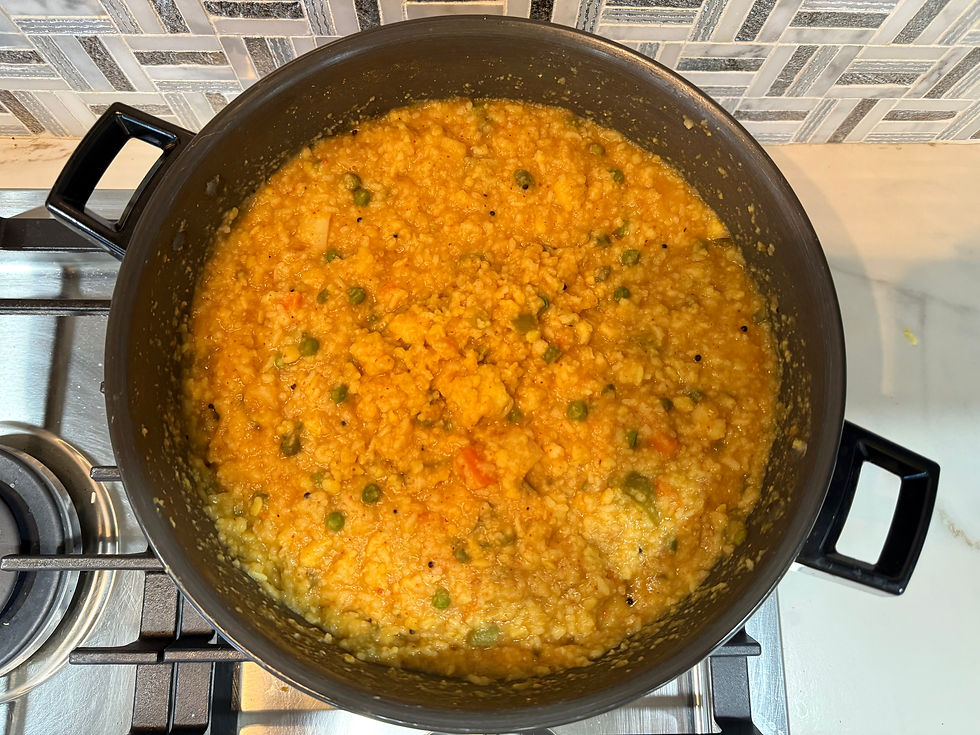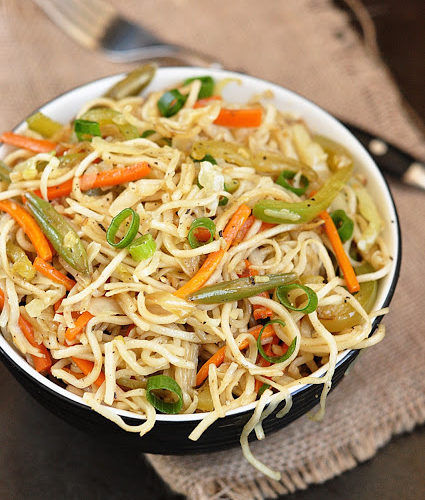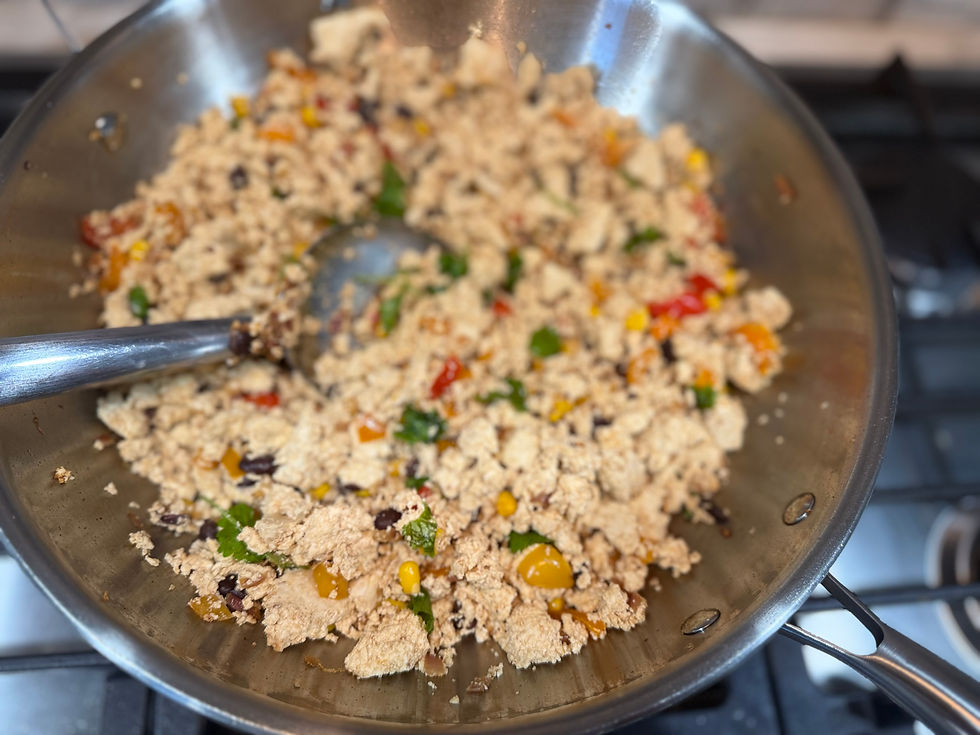Bisi Bele Bath
- Pooja Swamy
- Jun 1
- 4 min read
Today, I'm sharing a dish that's close to my heart and a staple in South Indian cuisine: the delightful Bisi Bele Bath. This flavorful one-pot wonder, translating to "hot lentil rice," is a perfect blend of lentils, rice, vegetables, and a unique spice mix that will tantalize your taste buds. It’s comforting, nutritious, and surprisingly easy to make once you get the hang of it.
Trust me, once you try this recipe, it'll become a regular on your meal rotation. So, let's dive right into the aromatic world of Bisi Bele Bath!
1. The Stars of the Show: Ingredients You'll Need
Here's everything you'll need to create this magic in your kitchen:
Rice: 1 cup (I prefer short-grain rice like sona masoori for that authentic texture)
Toor Dal (Split Pigeon Peas): 1 cup
Curry Leaves: A few sprigs
1 table spoon ghee/ oil: For cooking and tempering
Turmeric Powder: 1/4 tea spoon
Water: As needed
Onion: 1 large, chopped
Peas: 1 cup
Beans: 1 cup, chopped
Carrots: 1 cup, chopped
Capsicum (Bell Pepper): 1 cup, chopped
Potato: 1 large, cut into small, even-sized pieces
Mustard Seeds: 1 teaspoon
Hing (Asafoetida): A pinch
Salt: To taste
Tamarind Paste: 1/4 teaspoon (adjust to your preference)
Jaggery: 1/2 teaspoon (optional, but adds a lovely balance)
Bisi Bele Bath Powder: 1 table spoon. I use Adukale brand bisi bele bath powder.
Ghee: 1 teaspoon (for that final touch of richness)

2. Getting Started: The Preparation Process
Now for the exciting part – bringing all these wonderful ingredients together! Follow these simple steps, and you'll be enjoying a delicious bowl of Bisi Bele Bath in no time.
Step 1: Cooking the Rice and Lentils
Wash the rice and toor dal thoroughly under running water a few times. Transfer them to a pressure cooker. Add a few curry leaves, a little oil (this helps prevent sticking), and a pinch of turmeric powder. Add the required amount of water for cooking the rice and dal until they are very soft and mushy.
Pro Tip: The amount of water will depend on your cooker and the quality of rice and dal. Start with about 4 cups of water for this quantity and adjust as needed in subsequent attempts. Place the cooker on the stove and cook without the lid initially until the water level slightly reduces. This step helps retain the flavor. Then, secure the lid and cook for 4 to 5 whistles on medium heat, or until the dal and rice are completely soft. Let the pressure release naturally before opening the lid. Mash the cooked rice and lentil mixture gently with the back of a spoon. Keep it aside.
Step 2: Preparing the Vegetables
While the rice and lentils are cooking, let's get the vegetables ready. Chop the onion, peas, beans, carrots, capsicum, and potato into evenly sized pieces. Remember, consistency in size ensures they cook evenly.
Step 3: Tempering and Cooking the Vegetables
Take a wide-mouthed pan and heat a little oil over medium heat. Once the oil is hot, add mustard seeds. Let them splutter. Then add asafoetida (hing), turmeric powder, and a few curry leaves. Now, add the chopped onions and sauté them until they turn light golden brown. Add all the other chopped vegetables (peas, beans, carrots, capsicum, and potato) to the pan. Mix them well with the tempering. Sprinkle very little water, mix again, and cover the pan with a lid. Cook on medium flame until all the vegetables are tender. This should take about 8-10 minutes, depending on the size of your vegetables. Stir occasionally to prevent sticking.
Step 4: Bringing it All Together: The Flavor Infusion
Once the vegetables are cooked through, add salt to taste, tamarind paste, and jaggery (if using). Mix everything well. Now add the star ingredient: the bisi bele bath powder. Sprinkle it evenly over the vegetables and mix thoroughly, ensuring all the vegetables are coated with the spice blend.
Add water as needed to create a slightly thick gravy consistency. Let the vegetables and masalas simmer together for about 5 minutes, allowing the flavors to meld beautifully.
Finally, add the cooked and mashed rice and dal mixture to the pan. Mix everything very well, ensuring there are no lumps. Add more water if needed to reach your desired consistency – bisi bele bath is typically slightly runny.
Let the bisi bele bath simmer gently for another 5 minutes, allowing all the flavors to come together. Taste and adjust the salt, tamarind, or bisi bele bath powder if needed.
Step 5: The Grand Finale
Turn off the stove and stir in a teaspoon of ghee. This adds a wonderful aroma and richness to the dish.

Serve your piping hot Bisi Bele Bath garnished with a dollop of ghee, some crispy boondi (fried chickpea flour balls), or a side of potato chips. It's a complete and satisfying meal in itself!
There you have it – my tried-and-true recipe for Bisi Bele Bath. I hope you try this out and let me know how it turns out in the comments below. Happy cooking, and happy eating! Don't forget to share this recipe with your fellow food lovers!







Comments